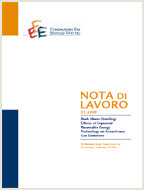Does the Swiss Car Market Reward Fuel Efficient Cars? Evidence from Hedonic Pricing Regressions, a Regression Discontinuity Design, and Matching

09.02.2014
Anna Alberini, Markus Bareit, Massimo Filippini
Q48, Q53, Q54
Fuel Economy, CO2 Emissions, Passenger Vehicles, Hedonic Pricing Model, Matching Estimator, Regression Discontinuity Design, Fuel Efficiency Premium, Discounted Future Fuel Costs
Climate Change and Sustainable Development
Carlo Carraro
To correct market failures due to the presence of negative externalities associated with energy consumption, governments have adopted a variety of policies, including taxes, subsidies, regulations and standards, and information-based policies. For example, labels that clearly convey energy consumption rates, associated costs, and emissions of conventional pollutants and CO2, have been devised and used in the last two decades in several countries. In 2003, Switzerland introduced a system of fuel economy labels, based on grades ranging from A to G, where is A best and G is worst, to assist consumers in making decisions that improve the fleet’s fuel economy and lower emissions. We use a dataset documenting all passenger cars approved for sale in Switzerland each year from 2000 to 2011 to answer three key research questions. First, what is the willingness to pay for fuel economy? Second, do Swiss drivers—or Swiss auto importers on their behalf—appear to do a one-to-one tradeoff between car purchase price and savings on fuel costs over the lifetime of the car? Third, does the label have an additional effect on price, all else the same, above and beyond that of fuel efficiency alone? Hedonic pricing regressions that exploit the variation in fuel economy across make-models, and over time within make-models, suggest that there is a (modest) capitalization of fuel economy into car prices. The diesel premium, however, exceeds the future fuel cost savings made possible by diesel cars, even at zero discount rates. An alternate calculation suggests that the fuel economy premium is consistent with a very low discount rate (2.5%). We use a sharp regression discontinuity design (RDD) based on the mechanism used by the Swiss Federal Office of Energy to assign cars to the fuel economy label to see if the label has an independent effect on price, above and beyond that of the fuel economy. The RDD approach estimates the effect to be 6-11%. To broaden the fuel economy range over which we assess the effect of the A label, we also deploy matching estimators, and find that the effect of an A label on car price is approximately 5%.
***
Suggested citation: Alberini, A., M. Bareit, M. Filippini, (2014), ‘Does the Swiss Car Market Reward Fuel Efficient Cars? Evidence from Hedonic Pricing Regressions, a Regression Discontinuity Design, and Matching’, Nota di Lavoro 16.2014, Milan, Italy: Fondazione Eni Enrico Mattei.
